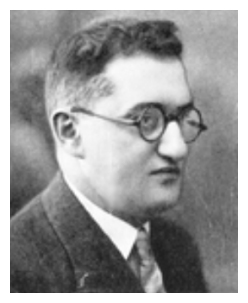
|
Translated by Gloria Berkenstat Freund
 |
Yitzhak Ajzen died in July 1931 at the age of 62. A rare type of Jew, he united in himself opposing qualities, for which he was beloved and esteemed by all strata of the Jewish population. On one side was the exceedingly Hasidic-religious; he would travel to the Aleksander court. On the other side – National-modern, with deep insight, as an old “Lover of Zion,” for the national revival of the Jewish people. At every Zionist celebration, whether this was a conference of K.K.L. or an evening of mourning for Dr. Herzl, Y. Ajzen always showed his smiling face to the public and devoured every word that was heard about the awakening of the old people of Yisroel.
There were hundreds of members in his funeral entourage, who came to give last respects to the deceased – a number that was then seldom seen at a funeral in Radomsk.
There are names that symbolize a certain status, an importance or an office. When one uttered the name of Reb Dovid Bugajski in Radomsk at the beginning of our century (Translator's note: the 20th century), it was known that who was meant was the Synagogue Warden of the city. The eminent businessman, the “contractor” of the highways in the Piotrków gubernia, the respected boss among bosses and the beloved father of a fine family.
The Bugajski family was large and widespread in Radomsk. as there were several brothers with children. However, Reb Dovid was exceptional, both in his virtues and in his wealth. To everyone he was a simple Jew; he did not hold himself [above everyone]; he was affable to all.
Even when he was no longer the Synagogue Warden, he was interested in Kehile affairs and always was ready to help when it was necessary to intervene with the official organs of the regime, who were drawn to him with trust and respect. In 1917 for example, his intervention assured that there was matzoh for the whole Jewish population, and it happened this way:
The Austrian occupation powers levied on special flour (that was then a rationed item) a tax that was so high that it was impossible for the majority of the population to be able to pay the price for the matzohs. Reb Dovid Bugajski courageously undertook to go alone to the power holders and obtained a decision that Passover flour would not cost more than non-Passover flour and thus all of the Jews ate Matzoh for Passover.
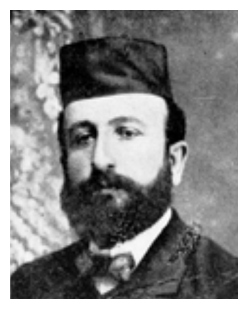 |
Yosef Behm was one of the prominent businessmen in the city, an active Zionist,
a Hebraist, an expert in Hebrew and Yiddish literature. If there was the
appropriate acceptance by the other side, he willingly carried out his
correspondence in Hebrew. In addition to a traditional Jewish education, his
sons received worldly knowledge, too, and studied Hebrew with Mr. Fajnzilber.
Yosef Behm was one of the few subscribers to Hatzfire (Translator's
note: A periodical published in Warsaw from about 1862 to 1931).
His knowledge of Torah and his general education served him very often in carrying out arbitration among merchants and among other strata of the population, both Jews and Poles. He was very active in the city's philanthropic societies, particularly in Linat ha-Tzedek (the poor house).
The cultural level and energy that dominated Radomsker youth after the satrapic Czarist regime surpressed the revolutionary ferment after 1905-07 must be underlined with particular satisfaction.
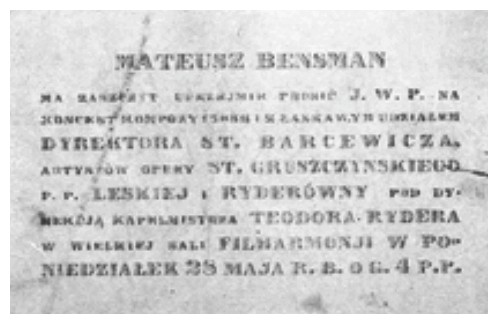
Invitation from Mateusz Bensman
|
As in other Jewish cities at the time, Radomsk also created Hazamir
and the Radomsker youth – with the help of several older social workers
– invited one of the most eminent musical forces in Poland at that time,
Mr. M. Bensman, as director of musical training in the Radomsker Hazamir.
Not many cities in Poland can boast [as can Radomsk] that in the years 1912-13, the Radomsker Hazamir presented the first act of the opera Di Yidn by Halevi in Hebrew under the direction of M. Bensman. If Radomsker landsleit who took part in that performance are still found anywhere in the world, they remember how much effort this cost. It was, indeed, one of the great artistic performances both by the Radomsker youth and by the great musician M. Bensman.
It was difficult for Hazamir to maintain M. Bensman as conductor, but despite the difficult material situation, he did not want to leave Radomsk. He had to add and produce the light operetta, Dos Pintele Yid in order to strengthen the financial situation a bit.
His students and sympathizers would often have great spiritual pleasure when he failed to turn off the gas lamps (there was no electricity in Radomsk at that time), sat down at the piano to play classical creations and simultaneously gave short clarifications about the creations.
M. Bensman was not only a great musician and conductor, but also an author of great musical compositions; a symphony with the title Eretz-Yisroel was performed by the Warsaw Philharmonia and in America, where M. Bensman later died.
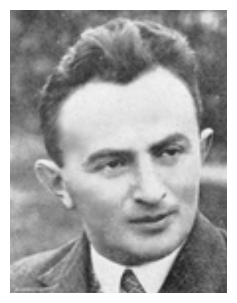 |
He came to us as a teacher from faraway Kolomyja; it was not easy for him to
find a common language with his surroundings and even more difficult for him to
win general sympathy. His first public communal outings ended with failure and
his first attempt “to break the ice” in school was met with stubborn
resistance.
[Page 457]
Time, however, did its work. It did not take long and soon one began to see in
this inconspicuous bent over teacher, a dear person and a good friend.
His knowledge was wide and deep – there was no field in which he did not feel at home, there was no subject that would be strange to him. He showed great respect to those listening to him, whoever it was, and felt a tremendous responsibility for the spoken word. This was his style in school and during his numerous lectures at the Folkes-University of the Sholom Aleichem Library, where he was the chief lecturer.
Yisroel Bromberg was not a Zionist; he, however, was united and bound with everyone in the Jewish community who were creative, rejoiced like a child at every accomplishment in the cultural field and with every revelation of a new talent.
The war found him in his birthplace, Kolomyja. When the storm passed, his surviving friends and students hoped that perhaps he had survived. This hope, alas, was not fulfilled.
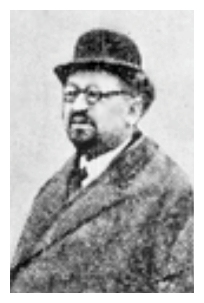 |
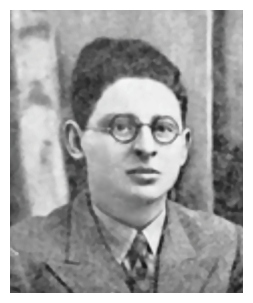 |
The first photograph already said that there was no mistake; from under the
glasses peered sharp, searching and unsatisfied eyes. First of all unsatisfied,
unsatisfied with himself and with the whole world.
[Page 458]
Once harnessed in the heavy weight of daily work for Keren Kayemet,
Haim pulled all year. It was not easy to pull along with him, but still more
difficult without him. If the monthly income fell short of the projected high,
his fury was heavy and sacred. When the income was more or less in the area
that was anticipated, it was most certainly the best sign that something was
being neglected and that with a little more energy and devotion, that month
could give a record income…
He understood and wanted everyone to understand that each donüm (22 acres – measurement used in Eretz-Yisroel) of redeemed land is a step closer to the Jewish redemption. When the Zionist organization renewed its activities, Haim became an active member in it. He never lost his hunger for aliyah; however, his dreams were not fulfilled. Haim Hartman, one of the builders of the pathways towards a Jewish state, perished by murderous hands together with his thousands and thousands of brothers.
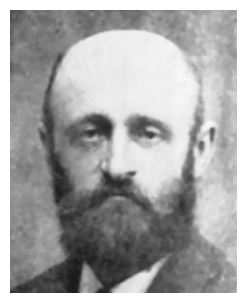 |
Born the 14th of Nisen 5647 (8th of April, 1887) to Moishe-Hirsh and Leah Waksman – an old and many branched Radomsker family. After kheder, he studied in the Radomsker Yeshiva, while at the same time studying Jewish bookkeeping, and prepared himself as a Torah reader with Sztatler, the fervid Zionist, from whom he was inoculated with the Zionist spirit and became one of the most devoted religious Zionists of that time. He was one of the first subscribers to Hatzfire in the city. After finishing at the Yeshiva and with the bookkeeping course with Sztatler, he became a business manager in Minczel's manufacturing business.
He married Gitl, the daughter of the fervid Amshinower (Mszczonów) Hasid, Reb Abraham-Yitzhak Feldman (the ribbon maker) in 1913 and opened a business, “20 Kopikes.” He had four children – three sons and one daughter. Two sons survived the Nazi gehinum and live in Israel.
Mikhael Waksman led a warm religious-Zionist house and raised his children in this spirit, permitting them to learn in the only Hebrew School in Radomsk of Dovid Erlikhman.
In 1923 he already had a Certificate of Immigration, but had to decline to immigrate because of family problems. Because of all of his later troubles, he could not fulfill his life's wish – aliyah to Eretz-Yisroel.
Mikhael Waksman was very active in Radomsker communal life. He helped found the Artisans' Union and the Y.L. Peretz Library, was the co-founder of Mizrakhi, secretary of the Palestine Office and co-worker in the Interest-Free Loan Fund in the city.
He dedicated his principal activity to the Artisans' Bank, which he founded with Wajnberg in 1925. He was treasurer of this bank for many years and, later, Vice Director.
Because of his work in the bank in which he was totally absorbed, he was forced to liquidate his business in 1928. A harsh economic crisis broke out in Poland in 1929 from which the Artisan's Bank also fell victim (ceased to exist in 1931). A difficult era began for Mikhael Waksman, who had already liquidated all of his private businesses and so it ran until the outbreak of war in 1939.
Shabbos, the 2nd of September 1939, when the Germans bombed the city, Mikhael Waksman and his family, like all Radomsker Jews, ran from the city. Returning to Radomsk after a certain time, he found he no longer had a roof over his head. Shlomoh Glikman's house at no. 11 (in the Market), together with half of the Jewish houses, was burned. Mikhael live with relatives and later moved with a large number of Jews to the Ghetto.
On the 9th of October 1942 during the first “selection” in Radomsk, Mikhael Waksman and his family were hiding in a bunker. The German discovered the bunker after three weeks and the 60 Jews found there were sent away to the transport to Częstochowa.
There is a hypothesis that Mikhael Waksman, Itzele the “Cemetery Jew” and six more Jews were not taken to Częstochowa, but that they were imprisoned in the Radomsker jail, tortured an entire night and shot in the Jewish cemetery in the morning.
On the threshold of the 20th century the photography studio of the
photographer Ludwik Wajnberg was located in Radomsk. The ceiling and two
walls of the studio were made of glass, hung with colored drapes that created
light and shadows for the pictures. In addition to this, there were various
decorations, such as a garden near water and the like.
[Page 459]
The photographer would hide under a dark cloth before photographing and there
he made his “strange art.”
The photographer, Ludwik Wajnberg only spoke Polish and this created a great distance between him and his Jewish clients. However, Ludwik Wajnberg possessed a natural inclination for community work for Jewish society. The Radomsker youth had begun to organize (in 1915-16), creating the “Youth Union” (in the attic room over Ahron-Wolf Szwarc's soda-water factory).
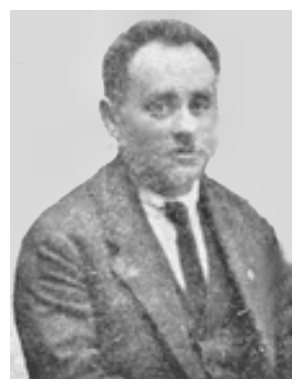 |
When it became necessary to move to a larger meeting hall (in Mr. Karp's house), it
was requested that the contract be signed by a businessman and not by an
ordinary “young person.” The responsibility then fell on photographer
Ludwik Wajnberg, and he became the chairman of the “Youth Union.”
Jewish Society in Radomsk built its institutions and when a Jewish Artisan's Union was organized, L. Wajnberg became the chairman of the Union and he helped the Jewish artisans organize and advance higher in their productive position.
Before the First World War, there was also a communal bank in Radomsk supported by Y.K.A. (Translator's note: organization founded by Baron Hirsh in Paris, which created loan offices in Poland). However, the war liquidated the bank. When a new Jewish Cooperative Bank was created (after the First World War), Ludwik Wajnberg was placed at its head. He led the institution with all of his abilities in the most difficult economic times It is certainly not his fault that the strong anti-Jewish wave of the Polish regime on the eve of the Second World War ruined this institution.
Ludwik Wajnberg, in the term of his 20 years as a communal activist in Radomsk suffered greatly. His comrades naturally showed all human weaknesses, such as opposition, slander and the like, and he could no longer maintain his income. His health weakened due to all of these quarrels. Thus he experienced everything that community workers must be ready to experience…
Hebrew text to be translated
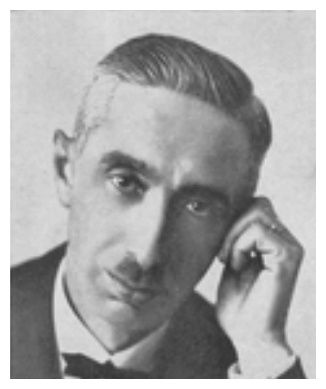 |
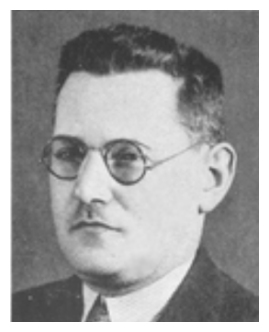 |
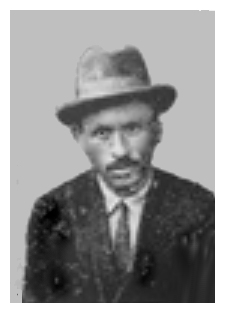 |
|
JewishGen, Inc. makes no representations regarding the accuracy of
the translation. The reader may wish to refer to the original material
for verification.
JewishGen is not responsible for inaccuracies or omissions in the original work and cannot rewrite or edit the text to correct inaccuracies and/or omissions.
Our mission is to produce a translation of the original work and we cannot verify the accuracy of statements or alter facts cited.
 Radomsko, Poland
Radomsko, Poland
 Yizkor Book Project
Yizkor Book Project
 JewishGen Home Page
JewishGen Home Page
Copyright © 1999-2026 by JewishGen, Inc.
Updated 25 Jul 2021 by OR